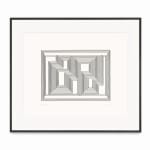-
Josef Albers
Prefatio, 1942Lithograph on Serie Whitewove paper19 x 24 in (48.2 x 61 cm)Edition of 30© 2025 The Josef and Anni Albers Foundation / Artists Rights Society (ARS), New York. Courtesy of Zeit Contemporary Art, New YorkJosef Albers' lithograph 'Prefatio,' from his 'Graphic Tectonics' series completed in 1942, is a profound exploration of geometric abstraction, created during his transformative years at Black Mountain College. This print...Josef Albers' lithograph 'Prefatio,' from his 'Graphic Tectonics' series completed in 1942, is a profound exploration of geometric abstraction, created during his transformative years at Black Mountain College. This print showcases Albers' meticulous study of form and the optical effects of line and plane interaction. The work features a stark, monochromatic palette that emphasizes the complex interplay of geometric shapes, which seem to advance and recede in a dynamic arrangement. 'Prefatio' exemplifies Albers' fascination with the perceptual possibilities of simple geometric forms, a theme that permeates his oeuvre. The lithograph's precise, clear lines and the arrangement of its shapes reflect Albers’ systematic approach to exploring visual perception and spatial effects, elements that became hallmarks of his extensive body of work.Albers' experience with the vibrant cultural landscape and architectural forms during his visits to Mexico profoundly influenced his artistic direction, as seen in 'Prefatio.' The structural clarity and spatial logic found in Mexican pyramids and colonial architecture resonated with Albers, informing the rigorous geometry and layered spatial constructs of his lithographs. His engagement with these forms during his Mexican trips in the 1930s enriched his visual vocabulary, which he further developed and abstracted in his works at Black Mountain College. Albers' integration of these influences solidifies his position in the history of geometric abstraction, bridging European Bauhaus ideas with American modernism and laying foundational concepts for movements such as Minimalism and Op Art. Through works like 'Prefatio,' Albers not only pushed the boundaries of printmaking but also contributed significantly to the discourse on the interaction between art, architecture, and perception.
Other proofs of this important lithograph are housed in the esteemed collections of the Museum of Modern Art in New York, the Metropolitan Museum of Art, New York, The Munson-Williams-Proctor Arts Institute, Utica, NY, Harvard Art Museums, Cambridge, MA, Yale University Art Gallery, New Haven, CT, The Josef and Anni Albers Foundation, Bethany, CT, the National Gallery of Art, Washington, D. C., and MACBA in Barcelona, Spain.
NOTES
Image: 11 5/8 x 15 3/4 in (29.5 x 40 cm)
Sheet: 19 x 24 in (48.2 x 61 cm)
This artwork is titled, numbered, signed, and dated in pencil, from the edition of 30.
Provenance
Private collection, United States
Private collection, New York
Literature
Brenda Danilowitz. The prints of Josef Albers: A Catalogue Raisonné, 1915-1976. New York: Hudson Hills Press in association with the Josef and Anni Albers Foundation, 2001, cat. no. 103 (another example illustrated).Brenda Danilowitz and Jeannette Redensek. Josef Albers: Discovery and Invention, The Early Graphic Works. London: Art/Books, Cristea Roberts Gallery, 2021, p. 116 (another example illustrated).




